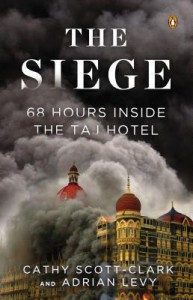Must Read

If you have seen the documentary shown on HBO about the 2008 Terror Attacks in Mumbai then you will want to read this book. If you are interested in current events, read this book. In people facing down the odds, read this book.
Quite frankly, read this book it is a powerful piece of writing.
The focus on book, quite obvious from the title, is the events that occurred in the Tajo hotel. If you want a blow by blow for the entire terror attacks then you are better watching the HBO (it would help to watch the film first, I think, to get the timeline in mind). While passing reference is made to events outside of the Taj, the focus is on the Taj. Biographical information is given both about the attackers and to some degree the victims. The authors trace the development of the attack to a degree as well.
The media here in the United States at least tended to focus not so much on individuals but as guests as a whole. When the hostage taking occurred, the focus was on those paying to be at the hotel as opposed to those who are paid to be at hotel. This book does much to change that and the heroic actions of the staff, most of whom would not have been able to afford a minute at the Taj as a customer. For my American perspective this was the best part of the novel because most of the news reports here focused on customers, foreigners, and not Indians.
This is not to say that guests are ignored. The paths of three groups of foreigners are followed, starting with the attack on the Leopold Café. Nor are wealthy Indians ignored. Some of the most gripping and poignant passages include the story of the Indian food critic, which as the New York Times Book review pointed out is parallel by the story of one of the chefs whose food she is reviewing. There are also the guests at the wedding, the Marine pilot, and the security personal. The young couple in love and the parents desperate to get back to their children alive.
But the best parts of the book, the ones that overwhelmed, gripped, and demanded that you do not put the book down, involved those who lives and/or deaths did not make big international news. The kitchen staff, the waiters, the police who went in knowing that they were massively outgunned. The manager whose family is trapped on the sixth floor. The man who goes back in for his daughter. It is those stories that truly grip the reader and make any interruption, any slowing of what happened annoying and frustrating.
For that is also what happens. Details are given about the planning leading up to the attacks as well as the attackers. It makes for a rather complete and damning picture of various agencies both in Indian and international stage.
In terms of layout, the book is well designed. There is a list of the people the authors follow at the beginning of the book. The people are divided into guests, staff, police, and terrorists. Pictures are below each description. Additionally, there is a complete list of the victims at the hotel at the back of the book. This includes not only guests and staff, but police and even the sniffer dog.
I do wish, fervently wish, that the authors will write a book about the attack at the other major hotel. The references made to events there, including a couple standing up to the terrorists and praying over the body of the victims seem to indicate that the story of that siege should be more widely known.
I suppose the question one must ask and consider is why you should read something about such in cruelty to fellow men. I suppose it is to know that cruelty and compassion go hand in hand. I suppose to understand or to try understanding more than what goes in your small corner of the world because in this era we are all connected.
 4
4
 2
2








